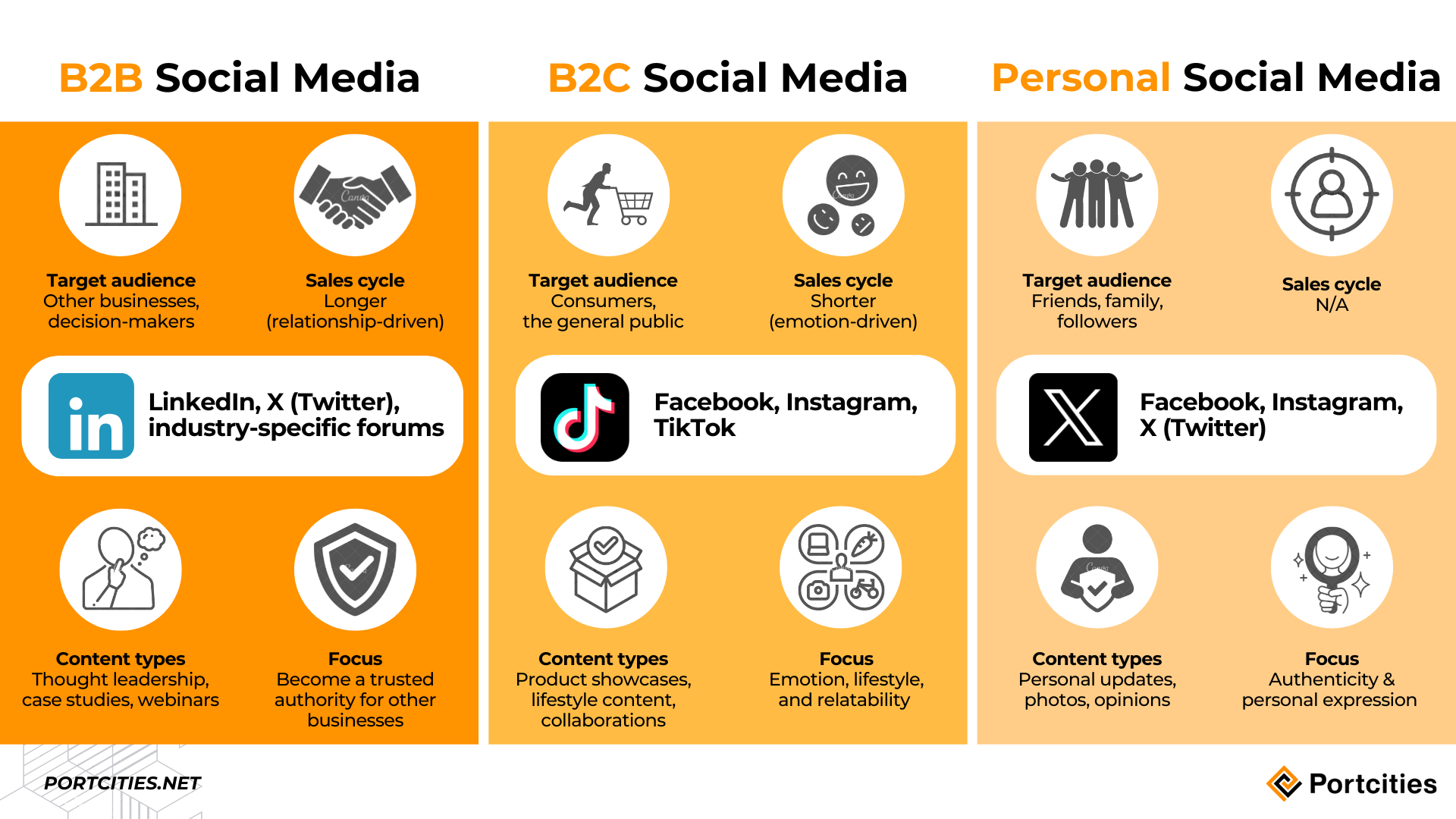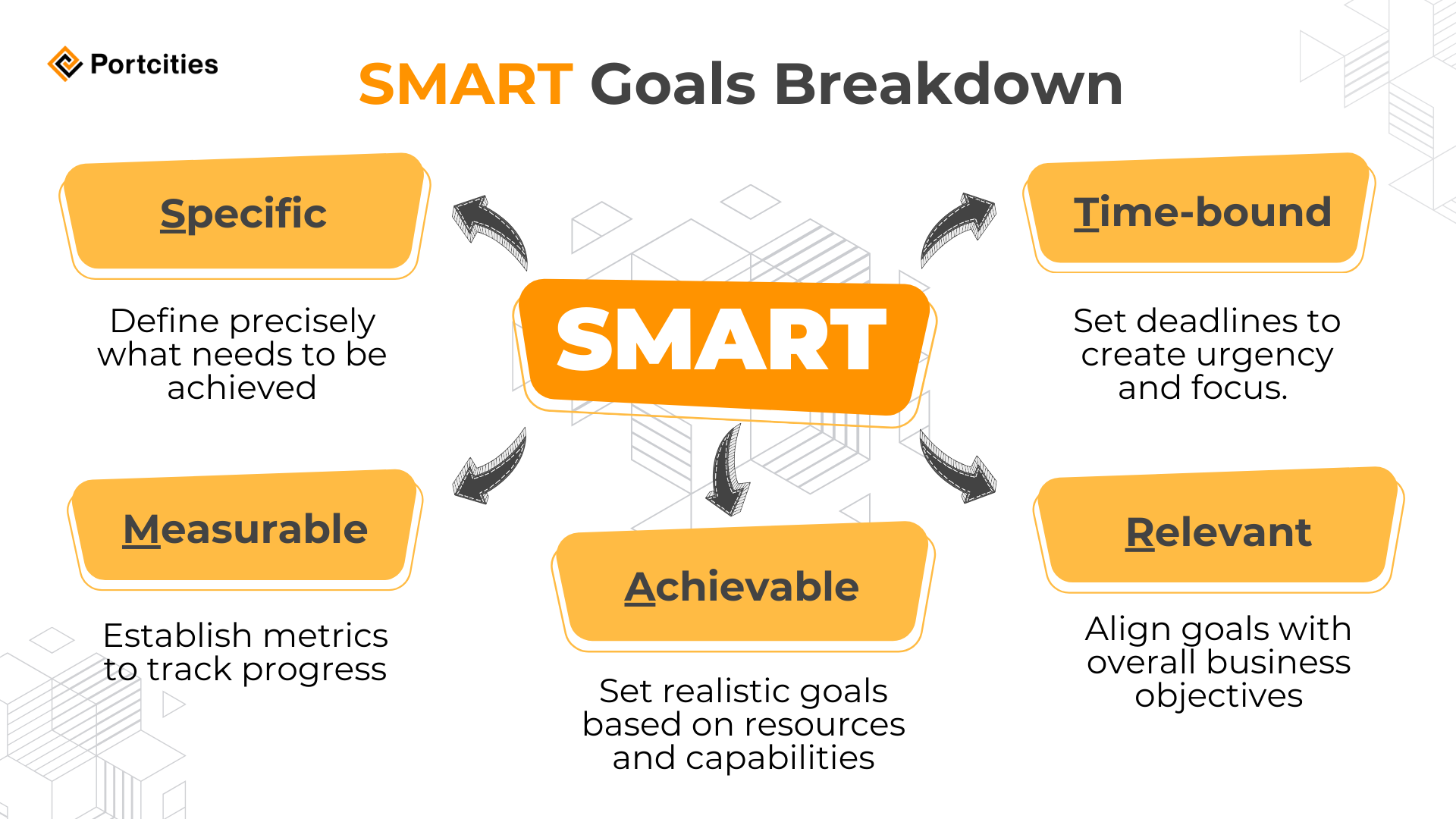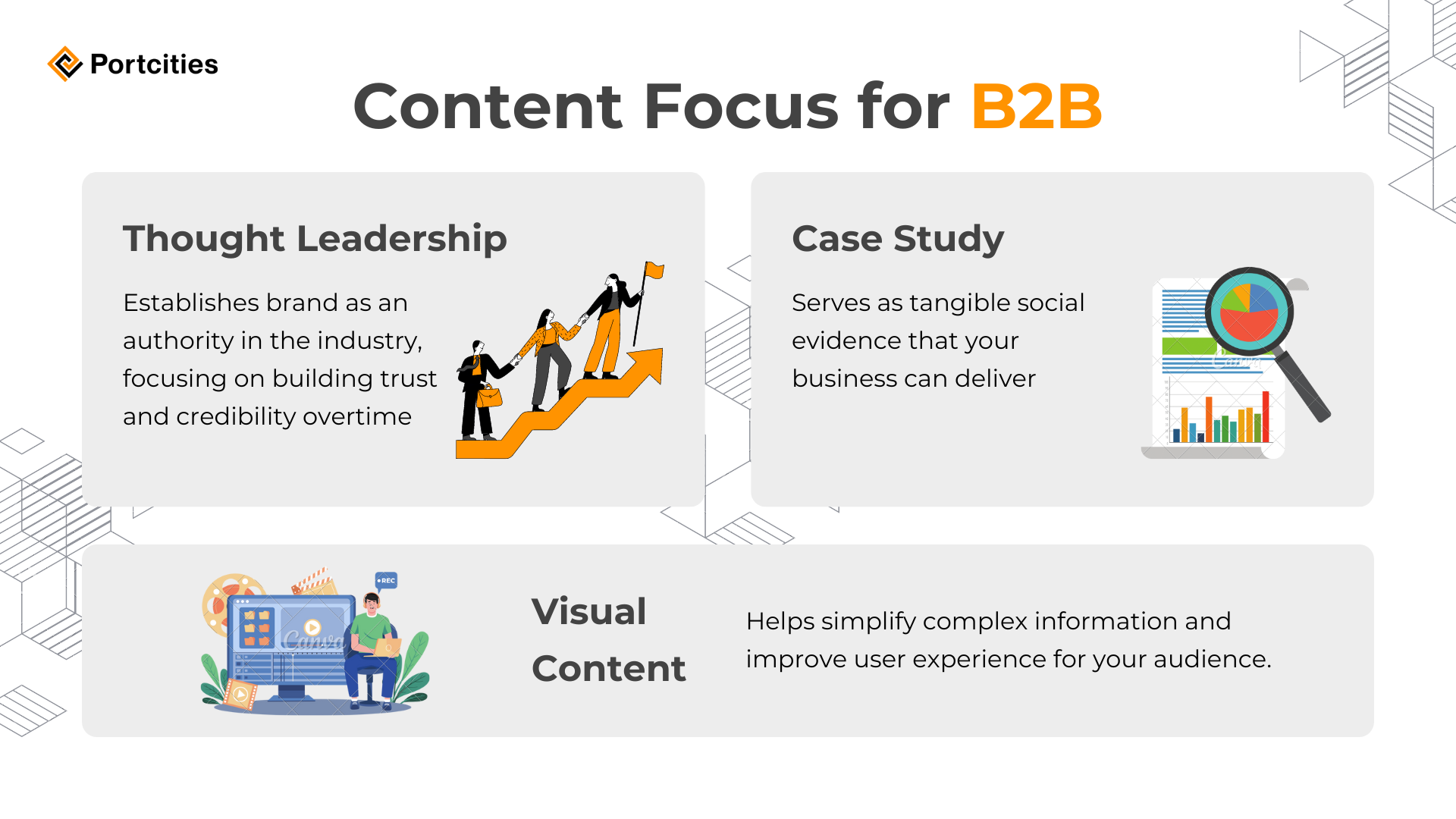Many businesses fail to utilize social media to grow their brand because they don't realize this simple fact: you don't treat B2B Social Media as you do with your personal account.
It's tempting, but please never post your breakfast or cat memes on your company's social.
Regardless of your company size, whether you are an SME or a large enterprise, everyone is dealing with the same problem:
- Algorithms that shift faster than a heartbeat
- Content creation race you’ve never signed up for
- Constantly engaging with your audience
Just because it’s hard, you can’t abandon it. The fact is that over 80% of B2B buyers start their purchasing journey with an online search.
So yes, B2B Social Media is a different beast. You can't slay it using a kitchen knife.
But it does not mean you can’t kill the beast; you just need a different tool kit.
Let's prepare your arsenal.
Understanding the Landscape
Like email marketing, each social media realm has unspoken rules, language, and purpose.
It is highly recommended that you adjust your business strategy based on your product and target market. To ensure you don’t waste a good strategy, you also need to know which platforms to use for your B2B.
We encourage you to eliminate guesswork by knowing the unspoken rules of online marketing based on three things:
1. Your target audience
2. What you sell
3. How to position yourself.
If you are looking for a checklist cheat sheet, you are welcome:

Surprised? Don’t be. B2C and personal social media thrive on emotion and immediacy.
However, the reason why B2B is different is because its goal is more targeted towards long-term relationships and trust-building. It’s everything about nurturing leads, showcasing expertise, and positioning your brand as an industry authority.
In ancient times, becoming a thought leader meant talking in conferences, seminars, and conducting a lot of presentations. Now, your B2B will have an easier time building rapport with your target audience, thanks to social media.
Read on to find out how.
Need help finding a social management app that connects with your CRM and sales pipeline?
We know just the app.
7 B2B Social Media Best Practices
Cutting down the chase, here are the best practices in digital marketing for your B2B business:
01. Define Clear Goals (Set SMART Goals)
Without clear goals, you’re making your content team create a campaign without direction.
You’ll end up not getting any audience, attracting the wrong crowd, or having different brand voices.
What’s worse, each leads to the same outcome: not generating any sales.
Usually, crafting a winning marketing strategy starts with a clear goal.
 We begin by outlining a broad objective, like boosting brand awareness. Then, we sharpen that focus into a specific goal, such as increasing organic website traffic by a set percentage within a defined quarter.
We begin by outlining a broad objective, like boosting brand awareness. Then, we sharpen that focus into a specific goal, such as increasing organic website traffic by a set percentage within a defined quarter.
To track progress, we identify key performance indicators (KPIs) like website sessions, bounce rate, and time spent on each page.
With these targets in mind, we map out specific tactics like content marketing or SEO to achieve them. Finally, we establish a timeframe for reaching our goal and identify the tools, like Google Analytics, that will measure our success.
This structured approach ensures our social media efforts are laser-focused and deliver measurable results.
If you have never created a marketing goal before, SMART goals keep you on track and help measure success:
- Specific: Define precisely what you want to achieve. Is it brand awareness, lead generation, or customer engagement? Instead of a vague goal like “increase sales,” consider: “Increase organic website traffic by 15% month over month.”
- Measurable: Establish metrics to track progress. For leads, track clicks and conversions; for brand awareness, measure impressions and engagement. Example: Boost landing page conversions by 20% per month by year-end.
- Achievable: Set realistic goals based on your resources and capabilities. Example: Generate 400 Marketing Qualified Leads (MQLs) per month by April
- Relevant: Align goals with your overall business objectives. Example: Improve Twitter engagement to enhance brand visibility
- Time-bound: Set deadlines to create urgency and focus. Example: Achieve a B2 Spanish language certification within 8-12 months.
Additional tips to consider when creating your B2B social media marketing goal:
- Benchmarking: Compare your goals to industry benchmarks or your past performance.
- Balance Short-Term and Long-Term Goals: While short-term goals drive immediate results, long-term goals ensure sustained growth.
- Alignment with Sales: Collaborate closely with your sales team to align marketing goals with revenue targets.
02. Consistent Branding
Quality content positions you as an authority, attracts leads, and fosters trust.
Envision that you encounter a brand with a witty Twitter presence, insightful blog posts, and visually stunning Instagram stories.
Does that brand seem more credible and trustworthy? Absolutely!
Consistent branding across all social media pages is the foundation of a strong social marketing strategy. By establishing a unified brand voice, tone, and visual identity, you make your brand instantly recognizable, fostering trust with your target audience.
Eventually, consistent branding increases brand visibility and paves the way for higher conversion rates.
 However, as a B2B company, what types of content should you focus on and why?
However, as a B2B company, what types of content should you focus on and why?
01. Thought Leadership
Thought leadership establishes your brand as an authority in your industry. It builds trust and credibility, helping you overcome objections and convince potential clients to choose your solution over competitors.
Share industry insights, trends, and expertise. Write articles, create webinars, and participate in discussions. For example, share snippets of past webinars where your experts discuss industry trends, share insights and provide actionable advice.
The best part is that you can repurpose the content of the webinars through articles and social media. You could also use different social media like YouTube to broadcast your webinars live.
02. Case Studies
88% of marketers consider case studies to be the most effective type of B2B content marketing. Case studies act as social proof, offering tangible evidence of the value your business can deliver. They build trust, credibility, and help potential clients envision how your product or service can address their pain points.
For instance, you can share a detailed case study in a carousel format over LinkedIn. Start by showcasing your clients’ problems and ending the carousel with what big impact your company has on the resolution.
Don’t forget to create an appealing and “to-the-point” title to go along with your case study.
03. Visual Content
Visuals grab attention, convey complex information, and improve user experience. They differentiate your brand and enhance understanding. According to Hubspot, 91% of consumers want to see more online videos from brands.
If you do not have a big content team, an alternative to videos are infographics and images. Whatever format you choose, it has to serve the purpose of conveying complex information succinctly.
For example, design infographics illustrating industry trends or product features. Create short explainer videos demonstrating how your goods or services work.
03. Content Targeting

We hate to break it to you, but gone are the days of generic social media posts.
If you have worked in marketing long enough, you’ll know that customer engagement is a crucial step towards conversions. Tailoring content to your audience ensures relevance and engagement. Today's audiences crave targeted content that resonates with their specific needs and interests.
Why does this matter to marketing?
Understanding your target audience's demographics, preferences, and pain points is important for tailoring your content to truly connect with your potential buyers (read: hello, lead generation!)
Finding all this information requires attention to detail and adeptness in marketing psychology:
- Research lets you dive deep into your target industries, competitors, buyer personas, and pain points.
- Segmentation helps divide your audience based on job roles, company size, and interests.
- Empathy: Just like any other marketing, put yourself in their shoes. What challenges do they face? What content would resonate?
- Ask: When crafting B2B social media content, tap into the insights of those who have experienced your services. Ask for their feedback and input to identify pain points that resonate with your audience and create a compelling hook for your posts. Plus, incorporating their testimonials adds credibility.
The best way to gain your audience’s attention is to pinpoint their problems. Mentioning your potential leads’ pain points allows people to feel connected with you within seconds. It will make people stop scrolling and want to know more about what you sell.
Then, highlight how your service or product can help them. Mention the advantages you have against your competitors.
04. Creating Optimized Posting Schedules
Ever wondered when the best time to post on social media is?
The answer: Different platforms have different peak engagement times. The timing of your social media posts can significantly impact their reach and effectiveness.
Optimal posting schedules, informed by social media analytics, ensure your content reaches your target audience when they're most active. This translates to better content visibility and more engagement.
According to recent studies by Hootsuite, posting at specific hours can boost engagement by up to 50%.
But here’s the catch: there’s no one-size-fits-all answer. Different platforms dance to their own rhythm, and your audience’s behavior varies. If we break it down, it looks something like this:
- LinkedIn: Weekdays, especially Tuesday to Thursday, during business hours. Professionals are in work mode, seeking industry insights and networking opportunities.
- Instagram: Evenings and weekends. Visual content thrives when people unwind and explore.
- Twitter: Weekdays, particularly during lunch breaks. Quick, concise updates resonate.
- Facebook: Late afternoons and evenings. Casual browsing time for a diverse audience.
The Art of Segmentation
We know that each platform hosts a unique audience, creating a natural segmentation.
While B2C brands thrive more on Instagram, B2B businesses can utilize LinkedIn as the perfect goldmine for industry-specific connections. Share thought leadership articles, engage in professional discussions and position your brand as an authority.
And if you are a CEO doing your own content, don’t forget to take care of your personal social media. A CEO’s Twitter account can humanize your brand and build trust.
The Role of Social Media Schedulers
Social media schedulers allow you to orchestrate your content. They matter because:
- Consistency: Schedulers ensure your posts hit the right notes consistently, so you won’t ever have to deal with frantic last-minute publishing.
- Time zones: If your business operates in one but sells more in another, you may want to reach global audiences without setting alarms for 3 AM. Simply schedule posts to align with different time zones.
We’ll talk more about making data-driven decisions later on, but a scheduler often has its own analytic tools that could help you analyze your posts’ performances and see the schedules that works best for your viewers.
05. Engage Authentically

Authentic engagement goes beyond likes and shares. By actively interacting with your audience, you build strong relationships, solidify your brand image, and cultivate lasting loyalty. This, in turn, translates to a more engaged community and a stronger foothold in your market.
Engagement on B2B social media goes beyond simply broadcasting messages. It's about fostering genuine connections and building relationships with your target audience. Here's how to create a thriving online community:
- Be responsive: People value their time. Make it a priority to respond promptly to comments, messages, and inquiries. This shows you care about their thoughts and fosters trust.
- Join the conversation: Don't just broadcast. Actively participate in industry discussions, answer questions posed by others, and share valuable insights. This positions you as a thought leader and builds a community around your brand.
- Always add value: Educate, inform, and empower your audience. Share industry insights, actionable tips, and thought-provoking statistics. Craft how-to guides, case studies, and trend analyses. Posts something that solves their pain points before they realize they have them.
- Show your human side: People connect with people. Offer glimpses into your company culture, introduce your team members, and share snippets of your workspace. This humanizes your brand and creates a sense of connection.
- Avoid generic vanilla AI: Steer clear of bland, robotic posts that make you sound like everyone else who uses the same technology and prompt. Instead, inject personality, wit, and authenticity into your B2B social media presence. Skip the generic corporate jargon and include some of your brand personality in your posts.
06. Never-ending Research
Reporting does not only matter in business operations like accounting.
Metrics guide your actions, allowing you to refine and improve over time. Your metrics allow you to analyze data, learn from successes and failures, and adjust your strategy.
Depending on your social media marketing objectives, you must pay attention to different metrics. Some examples:
01. Brand Awareness
Track your reach, impressions, and social media mentions to gauge how many people are seeing your content and engaging with your brand.
Tracking these metrics allows you to understand how well your brand is penetrating the market. High reach and impressions indicate visibility, but social media mentions reveal brand sentiment and engagement.
The implications? You can adjust your content strategy based on these insights to enhance brand awareness.
02. Lead Generation
Focus on conversion rates, lead generation numbers, and sales figures to assess how effectively your social media efforts are driving potential customers into your sales funnel. If you use Odoo, you can use its CRM features to create and track leads from your social media.
And with the acquired data, you can evaluate the effectiveness of your social media campaigns in driving potential customers into your sales funnel. If Odoo’s CRM features are utilized, you can directly attribute leads to specific social media efforts, allowing targeted follow-ups and personalized nurturing. Pretty simple, right?
03. Customer Engagement
Monitor engagement rate, comments, shares, and likes on your social media posts to understand how effectively your content resonates with your audience. Like metrics in brand awareness, you can maintain this using performance metrics in your social media accounts and, in some cases, your social media manager app.
This data lets you gauge how well your content resonates with the audience. High engagement rates indicate active interest. Analyze comments and shares to identify pain points, preferences, and opportunities for deeper connections. Use this data to refine your content strategy.
04. Campaign Performance
Measure campaign-specific metrics like click-through rate (CTR), cost per acquisition (CPA), and return on investment (ROI) to assess the effectiveness of your social media campaigns. You can track them using Google Analytics or Facebook Pixel, social media dashboards, and social media analytics tools.
Use the data to assess the impact of specific campaigns. A high CTR suggests compelling content, while a low CPA indicates efficient spending. ROI ties it all together—did your social media efforts translate into measurable business outcomes? Adjust campaigns based on these metrics to optimize results.
You can see that the fastest way to optimize your content strategy is through your own data. Some examples of how you can use the metrics on hand:
- KPI tracking allows you to monitor engagement, click-through rates, conversions, and follower growth.
- Use the data for A/B Testing to experiment with different content formats, posting times, and CTAs. Then, keep the one that resonates most with your audience.
07. Everybody Plays A Part

When talking about “working together,” there are two sides of the coin you need to consider:
1. Employee Advocacy - the least talked about strategy: Here, your employees play a role as your brand ambassadors to amplify your message.
Encouraging them to share company updates, industry insights, and success stories on their personal social media channels can exponentially boost your social media presence. But it’s not just about numbers; it’s about authenticity.
When employees genuinely engage, their networks take notice. Suddenly, your brand becomes more relatable, trustworthy, and human by covering the bases that appeal on a more personal level:
- Authenticity: Employee posts feel genuine. They’re not just promoting a brand; they’re sharing their experiences.
- Reach: Multiply your reach by tapping into your employees’ networks. Their connections trust them, making your message more impactful.
- Diverse Perspectives: Different teams—content creators, designers, customer service—bring unique insights. Collaborate. Learn. Adapt. Your marketing strategies will evolve organically.
2. Collaboration at work: Personal social media seems easy. However, you might notice that social media for branding requires constant monitoring and adaptation.
Having a social media manager app that allows collaborative workflows fosters teamwork, ensuring your social media strategy stays agile and effective. Plus, making sure only one brand voice is used throughout the social media posts creation process.
By involving different teams (content creation, design, customer service) in the social marketing process, you can leverage diverse expertise, respond to audience needs more efficiently, and ultimately develop well-rounded marketing strategies that convert.
Navigating B2B Social Media Strategies
Recognizing the distinct currents that flow through B2B, B2C, and personal channels are crucial. Each domain demands tailored strategies, and understanding their nuances helps us make impactful decisions.
B2B requires tangible evidence of your value, showcasing how your product or service solves real-world problems for other businesses. It is what differs B2B than B2C that predominantly appeals toward fast emotional connection for quick conversion.
Strategizing will take the bulk of your time and energy. Use a tool that could help you focus on setting your goal. Seamlessly manage campaigns, schedule posts, and engage your audience—all within one integrated platform.
Spend more time creating different A/B tests with different content types, posting times, and CTAs, and refine your strategy based on what resonates with your audience.
Let Odoo save you time as you create data-driven campaigns by analyzing your post-performance, tracking engagement, and measuring the impact of your social media efforts.
Intrigued? Ask for a demo from our ever-helpful experts.
